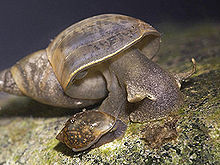Basommatophora
| Basommatophora Temporal range: Carboniferous–recent |
|
|---|---|
 |
|
| The larger of the two basommatophoran snails shown here is Lymnaea stagnalis | |
| Scientific classification | |
| Kingdom: | Animalia |
| Phylum: | Mollusca |
| Class: | Gastropoda |
| (unranked): |
clade Heterobranchia informal group Pulmonata |
| Families | |
|
See text |
|
| Diversity | |
| about 300 species | |
informal group Pulmonata
informal group Basommatophora
Keferstein in Bronn, 1864
See text
Basommatophora was a term that was previously used as a taxonomic informal group, a group of snails within the informal group Pulmonata, the air-breathing slugs and snails. According to the taxonomy of the Gastropoda (Bouchet & Rocroi, 2005), whenever monophyly has not been tested, or where a traditional taxon of gastropods has now been discovered to be paraphyletic or polyphyletic, the term "group" or "informal group" was used.
Basommatophora are known from the Carboniferous to the Recent periods.
Most of the families in this suborder are air-breathing freshwater snails. The three most abundant families in terms of number of species are, the Lymnaeidae (pond snails), the Planorbidae (ramshorn snails) and the Physidae (pouch or bubble snails). These are found in ponds, creeks, ditches, and shallow lakes nearly worldwide.
The Siphonariidae on the other hand are unusual in that they have secondarily returned to the sea, and are now sea snails, limpet-like marine gastropods which live in the rocky intertidal zone but which still breathe air and become active at low tide. The single species in the family Amphibolidae is archaic and retains an operculum. It lives at such a high tidal level that it could perhaps be considered semi-terrestrial. Members of the family Chilinidae are confined to temperate parts of South America, and the Latiidae are limpet-like and confined to New Zealand.
...
Wikipedia
